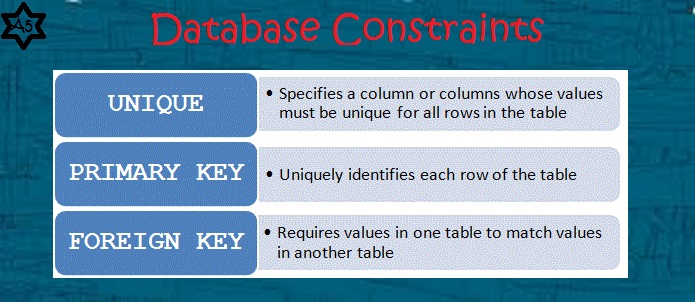Database Constraints: Key constraints in DBMS
Hello Friends, In this blog post(Key constraints in DBMS), I am going to explain the database constraints that are most excessively used while designing the database.
In this blog post(Key constraints in DBMS), we are going to discuss a few important questions related to database constraints like
What are the types of constraints?
What are the key constraints in the database?
What are the three types of constraints?
What are SQL Server constraints?
What do you mean by constraints?
What is an example of a constraint?
What are the primary key constraints?
Database constraints are also known as Integrity constraints in DBMS, CHECK constraints in SQL, Key constraints in DBMS, and Integrity constraints in SQL, so don’t be confused with their names they all are the same.
Integrity constraints in DBMS or key constraints in DBMS are the main key factors in managing, arranging databases or tables, and making the relationship between two or more database tables.
Within this blog, we are going to cover Integrity constraints in SQL and Types of constraints.
You would have read about the SQL database or DBMS then you will be quite familiar with CHECK constraints in SQL like UNIQUE constraint
Referential integrity constraint.
What are the useful database constraints?
These database constraints are a primary key, a unique key, and a foreign key.
when we start to design the project whether it is small or big, first we start to design the database.
If the database is done then more than half the work is done.
these three constraints stated above play a very important role in designing the database.
So now we look at them one by one.
Primary Key:
A primary key is a column in the table that uniquely identifies the tuple(row) values.
OR one single unique column that can fetch all information of that tuple(row). See the image below.

Unique Key:
It seems to be the same as the primary key but it has a few differences which make it different from the primary key.
This also uniquely identifies the tuple values.
What is the difference between primary and unique keys………?
The primary key makes the clustered index by default, whereas the unique key makes a non-cluster index by default. See the image below.

What are the clustered index and non-cluster index…..?
Cluster index:
In this context, all the id or primary keys are inserted in ascending order regardless of the order of the registration.
For example, employees of a company were asked the register to participate in a tech contest.
The employee makes the registration in the order as 202, 201,205,210…
But when their names are registered in the database their id order becomes 201,202,205,210…, So they are arranged in an ascending order whereas they did not come in the same order.
Non-cluster index:
This is the opposite of the clustered index the entries are stored in the same order as they come.
In the above example, the order would be the same when they are stored in the database as 202,201,205,210……
Another difference between primary key and unique is that,
In a table, there can be only one primary key whereas in a table there can be more than one unique key.
The primary key does not allow null values to be inserted.
The unique key accepts the null values.
Foreign Key:
A foreign key is a column in the table that helps us to extract all the information from the other table.
You are recommended a maximum of 16 foreign keys in one single database table. Although you can have
253 foreign keys though you will not be permitted to have this many keys for some performance issues.
It is a database constraint also sometimes called a friend key….?
Because the foreign key has a friend on another table and that friend is the prime leader or primary key of that table,
So it is very easy to take out the data from another table. See the image below.

So this is the explanation about these database constraints, We will update you with some more constraints in our upcoming blogs, so keep reading our blog post.
Quick Q&A: Key constraints in DBMS
What are the types of constraints?
Types of data constraints are given below:
Primary key
Foreign key
Unique Key
Not Null
Informational, etc.
What are the key constraints in the database?
The key constraints in the database are some rules which are used for managing and extracting the data in the database easily especially when the data is in bulk.
As the primary key is the set of one or more columns that uniquely identify the whole tuple value. And primary key and foreign are used to establish a relationship between the tables in the database.
You can also go through a few more amazing blog links related to DBMS below:
Composite key: Composite key vs Super key… What is the null value Problem in DBMS… What is the super key in DBMS… What is a candidate key in DBMS… What is Key in DBMS… BCNF – Boyce Codd Normal Form… 3NF – Third normal form… 2NF – Second Normal Form… What is1NF(First Normal Form)… What is normalization with an example… What do you mean by distributed DBMS and what are its types… What is DBMS ARCHITECTURE… DBMS vs RDBMS: What is the main difference between DBMS and RDBMS… What are the functions of DBA in DBMS… Integrity constraints in DBMS…
Conclusion:
So in this blog post(Key constraints in DBMS), we have learned about database constraints(Integrity constraints in DBMS). We learned about Types of constraints like a primary key, unique key, foreign key(Referential integrity constraint), and Primary key a unique column in our table that can identify the whole records or tuple value. A foreign key is used to establish a relationship with another table, the foreign key of a table becomes the primary key of another table.
A unique key(UNIQUE constraint) is just like a primary key that identifies the whole record from one column value. It only differs in a few manners from primary keys like the clustered index and null value assignment. Within this blog, What are the types of constraints, What are key constraints in the database, What are the three types of constraints, What are SQL Server constraints, What do you mean by constraints, What is an example of a constraint, What are the primary key constraints, |Key constraints in DBMS|
For any queries please feel free to write to us at a5theorys@gmail.com.
Hope! You would have liked this blog post Database constraint: Key constraints in DBMS.
Have a great time! Sayonara!


